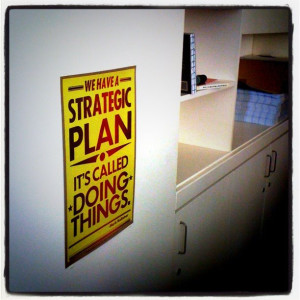I was having a discussion with my publisher and she asked if I was going to create any bookmarks for the upcoming book launch. I paused and thought,
sure. The next question out of my mouth surprised me. What do you put on a bookmark? Especially since this is not something I have ever thought about before. She said something of value for your readers. Since my book is called SET for Success, a roadmap to transform your business, it makes sense to outline the steps to go from strategic plan to action plan for you.
There are many steps to go through in order to create a solid executable plan. This is sometimes lost on business leaders and professionals who need to determine where the organization, department or team needs to go. The pressure cooker of the business world with its compressed timelines, accelerated requirements and ever changing external environment contribute to these common challenges. Unfortunately a quick planning fix is not always the best solution. There are times when you need to step back and do proper planning and implementation in order to create greater business success.
The 10 Steps to go from Strategic Plan to Action Plan
- Select the planning model and approach you will use: This is extremely important. There are many models and approaches to planning. One size does not fit all and it is easy to get caught up in the model flavor and approach of the week. In pre-planning make sure you select an approach appropriate for your business (size, demographics, type, people abilities, etc.).
- Identify your key stakeholders: Do proper stakeholder analysis for internal and external stakeholders with consideration for their impact and influence on your business. If you are not sure whether they are a stakeholder put them on your list. It is better to sort that out a little later than miss them altogether.
- Establish the questions you need answered: The best rule of thumb is to “question everything about your business”. Good questions go a long way to help people prepare for planning and understand challenges that must be addressed. There are standard questions you can ask to understand your business better.
- Determine where you and your team need to go: True strategic planning starts with the end in mind. Lots of people miss this important point. Stepping through the processes to create, clarify or update your mission, vision of success and then establishing strategic agenda items and strategic initiatives is all part of determining where you need to go and what you are going to focus on.
- Focus on your key business impact zones: There are four business impact zones; process and productivity, tools and technology, business development and people and culture. These impacts zones are touch points in your business. Make a change in one and you send ripple effects throughout your organization. To have a smooth running machine you need to address your four impact zones and fine tune them appropriately.
- Create a strategy map outlining key business focus areas: A strategy map is the graphical representation of all the key business decisions you and your team made. It brings all the pieces together. Each business impact zone is a way of categorizing all the moving parts of your organization. Your business measurements will be outlined for each impact zone, regardless of whether they are leading or lagging indicators. In today’s world most strategic maps are on a couple of 11X17 inch sheets of paper so people can see everything at a glance.
- Build an implementation roadmap to guide your business: The roadmap is the translations of the strategic map into its executable components. It outlines strategic initiatives, champions, and key elements (buckets of work), alignment pathways, and time lines. This is your implementation plan. The roadmap helps you visually bridge the gap from the strategic to the tactical and align with the business vision of success and strategic agenda items.
- Establish work plans: Work plans provide the information your people need to know what the expectations are for moving the company forward. In addition, the high-level work plans also serve as a guide for management to deliver on work elements. Work plans help you make further business decisions. Thinking through the work plan process allows you to take a look at your three primary constraints—time, money and resources—and allocate them accordingly. This, in turn, allows your people to start moving forward on the nuts and bolts of the plans, turning your strategic planning into actual realities.
- Create a communication plan to engage people: Not sure why, but a lot of organizations ignore their communication plans. Then they wonder why they have communication problems. The communication plan is an important part of ensuring the correct message is delivered. It outlines exactly how people are to be engaged in the process. It’s an integral part of creating your business culture and getting work done through people. If you don’t communicate effectively you will not get to where you need to go.
- Go the distance: Making sure the senior management team is prepared is a vital component, but it’s not the only one. You need to make sure all of your people are prepared for the implementation of your strategic, tactical and operational plans. You need to continue to implement your plan and use it on a regular basis (as you agreed in your execution planning). You made it this far, so go the distance. Make it work. Make the investment that will keep your plan alive. Use it in your meetings, reference it, test your people on it and make adjustments as needed. No business leader or champion stops at the starting gate—they take what they’ve learned, agreed to, and developed, and they put it into real life practice. You need to do the same.
Strategic planning to action roadmap planning is really a 10 step process. Yes there can be short cuts. We all take them on the road to our business success. But short cuts are something you can do temporarily. Eventually you may find yourself back at the starting gate and stepping through the process because you missed something. Either way creating a strategy map and a roadmap will serve as a guide for your business success. All this to say, on the back of my bookmark I will have the 10 Steps to be SET for Success in Your Business through strategic planning and action roadmap development. I hope that this will provide you point of reference value.










